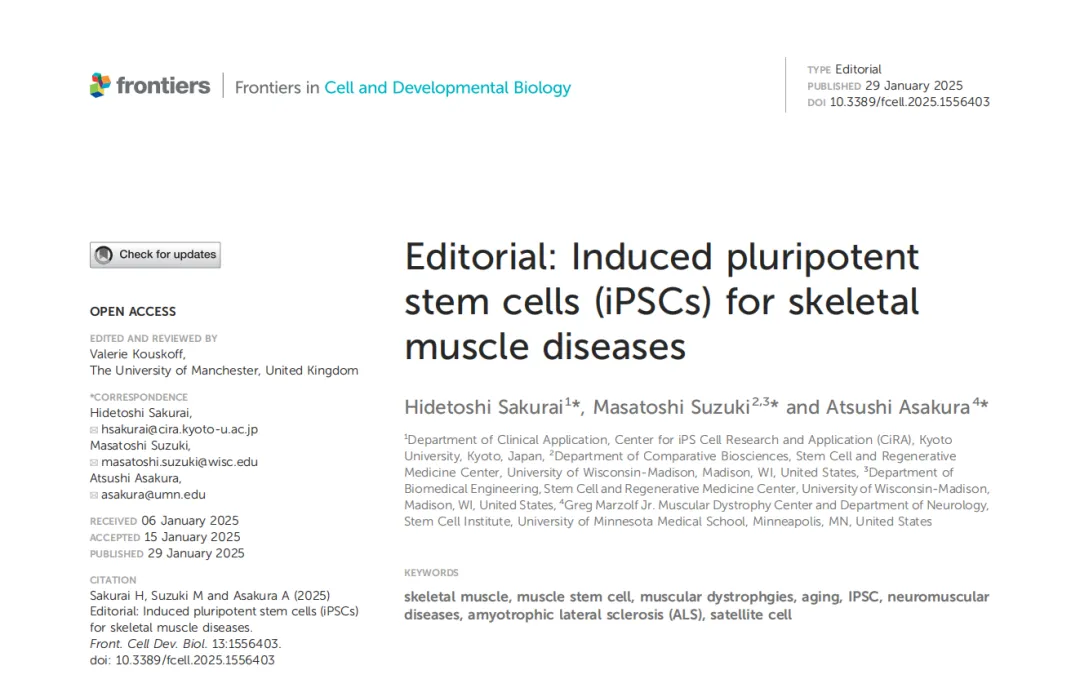
On January 29, 2025, The review Induced pluripotent was published in the journal Frontiers in Cell and Developmental Biology by experts from the iPSC Research and Application Center (CiRA), Kyoto University, the University of Wisconsin-Madison, and the University of Minnesota stem cells (iPSCs) for skeletal muscle diseases, this review explores the application of iPSCs in the treatment and modeling of skeletal muscle diseases.
The review mainly introduces readers to five research papers, the first of which discusses the method by which iPSCS differentiate into muscle cells (Molin et al., 2021), The second paper focuses on the role of fiber/fat progenitor cells (FAPs) in muscle connective tissue and their relationship with ectopic ossification (Nakajima and Ikeya, 2019), and the third paper finds that leukemia inhibitory factor (LIF) promotes self-renewal of MuSCs. Enhanced transplantation effect (Mead et al., 2023), the fourth article revealed the mechanism of amyotrophic lateral sclerosis (ALS) by using iPSCs myocytes model carrying SOD1 mutations (Lynch et al., 2019; Zhou et al., 2023), and the last one explored the effect of serum on stem cell muscle differentiation, providing new insights into the mechanism of muscle aging (Tey et al., 2024).

China's aging population is increasing the number of muscle degeneration patients by 1.8 million a year, and traditional therapies are leading to an 18 percent annual increase in medical expenditures. The large-scale application of iPSCs technology can not only improve the quality of life of patients, but also relieve the pressure on the public health system. This article will discuss the medical value of this transformative technology from three aspects: avoiding immune rejection by autologous transplantation, repairing mutations by gene editing, and accelerating drug development by disease models.
Autologous transplantation avoids immune rejection
iPSCs are derived from the patient's own somatic cells, which can be restored to a state similar to embryonic stem cells through reprogramming technology, and then can differentiate into a variety of cell types, including skeletal muscle cells, whose genetic background is completely consistent with that of the patient, so that the immune system will not recognize and attack during transplantation, thus effectively avoiding immune rejection. This property makes iPSCs a significant advantage in the treatment of skeletal muscle diseases such as muscular dystrophy (DMD) and amyotrophic lateral sclerosis (ALS), providing patients with a safer and more effective treatment option.
In addition, iPSCs technology also circumvents the ethical issues of traditional embryonic stem cell therapy, further promoting the feasibility of cell therapy in clinical applications.
Gene editing to repair mutations
Using gene-editing techniques, such as CRISPR-Cas9, it is possible to precisely repair disease-causing genetic mutations in iPSCs, generating cells with normal gene function for treatment.
CRISPR-Cas9 technology works by designing a single-stranded guide RNA (sgRNA) that is complementary to the target DNA sequence, instructing the Cas9 protein to locate and cut a specific site on the target gene, and subsequently introducing the desired gene repair through DNA repair mechanisms within the cell, such as non-homologous end linking or homologous recombination. This approach not only corrects disease-causing mutations, but also avoids the off-target effects and immune responses common in traditional gene therapy.
Disease modeling to accelerate drug discovery
iPSCs have significant value in disease model building and drug development. iPSCs are capable of differentiating into a variety of cell types, including skeletal muscle cells and nerve cells, which can be used to build highly physiologically relevant disease models.
Compared with traditional animal models, IPSCs-based disease models can more accurately simulate the pathological mechanism of human diseases, avoiding the biological differences between animal models and human diseases. In addition, iPSCs come from a wide range of sources, are not ethically restricted, and can be expanded indefinitely, providing a stable and efficient cellular platform for drug screening. This model not only helps accelerate the process of drug development, but also reduces the cost of research and development and improves the accuracy and efficiency of drug screening. Therefore, iPSCs have become an important tool to promote drug development and disease mechanism exploration in the research and treatment of skeletal muscle diseases.
In the future, with the continuous development of iPSCs technology, it is expected to achieve more accurate disease modeling and more effective treatment strategies. On the one hand, myogenic cells derived from iPSCs are expected to play a greater role in clinical therapy by optimizing differentiation and transplantation programs. On the other hand, combined with gene editing and drug screening technologies, the iPSCs model will provide stronger support for personalized treatment of skeletal muscle diseases.